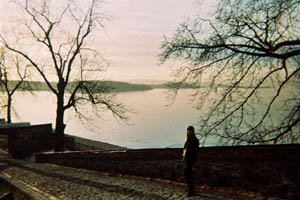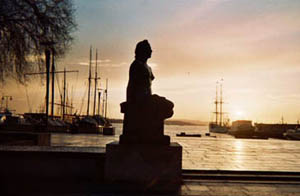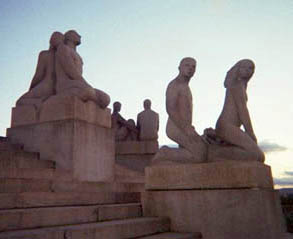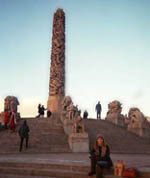Oslo in Winter is Quite an Art
Oslo
by Sarah Shuckburgh
Norway’s capital may not be the most obvious destination at this time of year,
but Sarah
Shuckburgh finds the atmosphere magical, with plenty in the museums,
galleries and streets
to enchant the visitor.
 As we speed into Oslo on the smooth airport express, the
midday sun hangs low in a pale grey sky. Mist hangs in dark
pine forests. In winter, the sun rises at 9.15 and dawn
lasts all morning. Inching along a rosy horizon, the sun
slowly heaves itself to an altitude of 7 degrees, barely
above the trees, as the clouds gradually brighten to a cool,
luminous grey. As we speed into Oslo on the smooth airport express, the
midday sun hangs low in a pale grey sky. Mist hangs in dark
pine forests. In winter, the sun rises at 9.15 and dawn
lasts all morning. Inching along a rosy horizon, the sun
slowly heaves itself to an altitude of 7 degrees, barely
above the trees, as the clouds gradually brighten to a cool,
luminous grey.
My daughter Hannah and I have come to Oslo for a wintry
weekend. We alight at the National Theatre station, check
into the conveniently positioned Hotel Continental, and set
off in the gloaming to explore. The city exudes an air of
calm – the streets are almost empty. An occasional bus or
tram glides up, opens its doors and disgorges a few
well-muffled passengers. There are few cars, and, in this
chilly weather, no bicycles. Pedestrians are sensibly shod
in fur-lined boots or rubber galoshes, but nobody is in a
hurry. Welcoming candles flicker from shop thresholds.
Carillons chime from the town hall every quarter hour, and
gulls squawk from the darkening sky. We climb to the
fortress overlooking Oslo Fjord and happen upon a sombre
Resistance Museum with deeply moving mementoes of
occupation, resistance and liberation, and crackly
recordings of Churchill and King Håkon VII. That evening, we
dine on reindeer steaks at the fashionable Café Christiania,
amid an eclectic jumble of period bric-a-brac.
 In the morning, after a breakfast of herring, mackerel,
black bread and rubbery goat’s cheese, we seek out Edvard
Munch, expressionist innovator, and Oslo’s most famous son.
We start at the National Gallery and make for a room of
melancholy Munchs, including his bare-chested Madonna and a
small, roughly-drawn Scream. In the Kiss, two lovers embrace
by a window, through which we glimpse a street, cool and
grey like Oslo. I am mesmerised by Munch’s painting of his
dying auburn-headed sister and grieving mother, and by his
sorrowful Spring, in which an invalid is warmed by watery
sunshine. In the morning, after a breakfast of herring, mackerel,
black bread and rubbery goat’s cheese, we seek out Edvard
Munch, expressionist innovator, and Oslo’s most famous son.
We start at the National Gallery and make for a room of
melancholy Munchs, including his bare-chested Madonna and a
small, roughly-drawn Scream. In the Kiss, two lovers embrace
by a window, through which we glimpse a street, cool and
grey like Oslo. I am mesmerised by Munch’s painting of his
dying auburn-headed sister and grieving mother, and by his
sorrowful Spring, in which an invalid is warmed by watery
sunshine.
Deciding against a candle-lit table on the pavement,
where customers huddle beneath rugs and fur pelts, we stop
for elevenses at United Bakeries on Karl Johans gate.
Baskets of fresh rolls, pastries and loaves trundle slowly
overhead on a creaking pulley contraption which links the
shop with the underground kitchen. Chandeliers, marble
tables and an antique range give the tearoom a nostalgic
feel - but our coffee is served in paper cups.
 Revived, we take the T-bane to the Munch Museum. Two
major works were stolen by armed robbers in 2004, and now
the security is extreme, with airport-style screening,
electric doors sealing each gallery, and sliding
bullet-proof screens in front of the paintings. Munch paints
depression, despair, disease and death. Landscapes are
wintry and bleak; domestic scenes are melancholy; his
characters are full of angst and torment; his self-portraits
have down-turned mouths. Hannah and I love them all. Revived, we take the T-bane to the Munch Museum. Two
major works were stolen by armed robbers in 2004, and now
the security is extreme, with airport-style screening,
electric doors sealing each gallery, and sliding
bullet-proof screens in front of the paintings. Munch paints
depression, despair, disease and death. Landscapes are
wintry and bleak; domestic scenes are melancholy; his
characters are full of angst and torment; his self-portraits
have down-turned mouths. Hannah and I love them all.
We return to the waterfront and have lunch at Lotofens, a
chic fish restaurant. Bravely, we order rakfisk – chunks of
strong-tasting trout, rotted for six months, and served with
beetroot, onion, sour cream and unleavened bread. Outside,
beyond the wooden boardwalk, Oslo fjord shimmers grey and
silver, and distant forests form a steely horizon. The sun
starts its inexorable descent into an apricot sunset, and
finally disappears soon after 3pm.
Hannah is indefatigable, and insists on visiting two more
galleries – the Samtidskunst, which houses challenging and
disturbing works by post-war Norwegians in a stately art
nouveau building, and, nearby, the Astrup Fearnley museum,
where a private collection of recent works by Norwegian and
international artists is displayed in a striking new
building with curved concrete walls.

Back at our hotel, we collapse in the bar, and admire its
Munch lithographs – unfamiliar versions of Melancholy and
the Kiss, and a sombre self-portrait. Then we retire to our
room for baths of alarmingly brown water which we disguise
with bubbles. ‘Who Wants to be a Millionaire’ is on
television - in Norwegian - and we manage to grasp one
question: where is London’s National Gallery? Is it
Piccadilly, Leicester Square, Trafalgar Square or the Mall?
The contestant guesses wrongly, but we can hardly blame her.
Hannah and I can’t remember the address of Oslo’s National
Gallery, even though we were there this morning – was it Universitetsgata, Stortingsgata, Rådhusgata or Karl Johans
gate?
Oslo’s streets are full of sculptures, and much of the
city’s art costs nothing to enjoy. Not so the food and
drink. Our guide book suggests bargaining for leftovers at
closing time – and now we know why. Prices are astronomic.
But we are determined to sample Norwegian specialities
whatever the cost, so at 8 o’clock, we join the elderly but
well-heeled clientele at the 19th century Engebret Café,
opposite the Samtidskunst. A waitress with blond plaits and
a frilly apron translates the daunting menu: ‘many animals
and fishes, sheep-heads, pig-ribs, fish-eggs, ox, elk, and
the house speciality, lutefiskaften’. We choose the latter
(sharing a single helping, as the price translates as £35)
and are presented with a mountain of white fish, bowls of
potatoes and puréed peas and a vat of hot dripping dotted
with cubes of bacon. The fish is so salty that we gasp for
water, but, copying our neighbours, we order tankards of
beer, and tiny glasses of spicy golden akevitt, which tastes
of nail varnish remover. We watch in astonishment as other
diners empty their bowls of fat over the fish and gobble
everything up. Stranger still, we notice that after the main
course, each table is laid again and all the dishes reappear
– fish, potatoes, pea purée and bacon swimming in fat. We
beckon the waitress, who explains t hat lutefiskaften
includes unlimited servings. All diners tackle two or three
rounds; some eat six - including six pints of fat. Hannah
and I feel so full after half a lutefiskaften that we can’t
even attempt a pudding of cloudberries and cream. hat lutefiskaften
includes unlimited servings. All diners tackle two or three
rounds; some eat six - including six pints of fat. Hannah
and I feel so full after half a lutefiskaften that we can’t
even attempt a pudding of cloudberries and cream.
On Sunday, Oslo is even quieter than usual. Shops are
closed, and streets are deserted. After strolling through
the undulating gardens of the royal palace, past sentries
yawning beneath feathered helmets, we take the number 30 bus
through genteel suburbs to the Bygdøy peninsular. Our first
stop is the Kon-Tiki museum, which gives a vivid and
evocative account of the exploits of Thor Heyerdahl, the
brilliant, handsome latterday Viking explorer. His craft, Ra
II and Kon-Tiki, look remarkably flimsy. In the gift shop,
Hannah finds the weekend’s only bargain – a Kon-Tiki
tee-shirt for £4.
 We stride up the road, breathing fragrant pine, and
glimpsing the fjord between brick-red clapboard houses. Soon
we reach the impressive Viking Ship Museum – a white
church-like building containing three ancient oak ships,
their sculptural, sweeping lines simple but elegant, their
ornate prows preserved in the clay of chieftains’ graves.
Various artefacts have also survived - shoes, carved
bed-heads and sleighs, and remarkable fragments of patterned
cloth. We stride up the road, breathing fragrant pine, and
glimpsing the fjord between brick-red clapboard houses. Soon
we reach the impressive Viking Ship Museum – a white
church-like building containing three ancient oak ships,
their sculptural, sweeping lines simple but elegant, their
ornate prows preserved in the clay of chieftains’ graves.
Various artefacts have also survived - shoes, carved
bed-heads and sleighs, and remarkable fragments of patterned
cloth.
Another stroll brings us to the Folk Museum, with
colourful costumes, bridal crowns, and handmade painted
furniture. We peep into turf-roofed farmhouses and granaries
and yearn to simplify our own lives, with log fires and box
beds. Cool sunshine casts long shadows on wooden floors. On
a hill stands a 12th century stave church – one of only 29
in Norway – a pagoda-like tower held together with stakes
hammered into the ground. The wooden doors and finials are
intricately carved. A traditional village has been
reassembled, with sandy lanes linking grocery, chemist, post
office, dairy farm and cottages. In summer, every building
is open and you would want to stay all day, but even in
winter there is plenty to see. In one shop, a pregnant
assistant in traditional costume is knitting by the fire
while she waits for customers. In the bakery, another
villager is preparing dough with a dimpled rolling pin, and
serving delicious flat cakes – hardangerlefse – hot from the
open fire.
 We catch another bus to Vigeland Park. I had never heard
of him, but in Oslo Vigeland is a household name, and his
former home is a museum. Massive sculptures of entwined
naked bodies fill every room - stone babies, youths, adults,
wrinkled oldies and skeletons pose in weird knobbly trees;
naked mothers stoop to comfort naked sons. I love the
sculpture, but Hannah hates it. Our disagreement continues
in the park, which is dominated by a 60-foot granite obelisk
of writhing bodies (‘phallic and grotesque’, says Hannah),
surrounded by statues of laughing children, crouching
crones, embracing couples and moody old men – all stocky,
sturdy, sinewy, smooth. The park is an intriguing mix of
living families, warmly wrapped against the winter weather,
and equally large crowds of unclothed figures, running,
jumping, smiling, frowning – but frozen in granite or
weathered bronze. I think the statues look wonderfully
dramatic against the pink sunset, but Hannah says they’re
kitsch. We catch another bus to Vigeland Park. I had never heard
of him, but in Oslo Vigeland is a household name, and his
former home is a museum. Massive sculptures of entwined
naked bodies fill every room - stone babies, youths, adults,
wrinkled oldies and skeletons pose in weird knobbly trees;
naked mothers stoop to comfort naked sons. I love the
sculpture, but Hannah hates it. Our disagreement continues
in the park, which is dominated by a 60-foot granite obelisk
of writhing bodies (‘phallic and grotesque’, says Hannah),
surrounded by statues of laughing children, crouching
crones, embracing couples and moody old men – all stocky,
sturdy, sinewy, smooth. The park is an intriguing mix of
living families, warmly wrapped against the winter weather,
and equally large crowds of unclothed figures, running,
jumping, smiling, frowning – but frozen in granite or
weathered bronze. I think the statues look wonderfully
dramatic against the pink sunset, but Hannah says they’re
kitsch.
 That evening, we dine at Havsmak, a seafood restaurant
overlooking the king’s floodlit palace. We guzzle an
expensive feast of scallops, crayfish and catfish. Walking
home through the crisp night air, we pass a long-legged
statue of Håkon VII, King of Norway from the country’s
independence in 1905 until his death in 1957. Despite the
bitter chill, groups of scantily clad smokers, banned from
bars and restaurants, stand on street corners. Buskers don’t
seem to notice the cold either, and are still playing
melancholy folksongs on tambourines and accordions. We have
spent a small fortune on food and drink, but we find
ourselves enchanted by this quiet city, surrounded by wintry
fjords and forests, and benighted – in the best sense - for
18 of every 24 hours. That evening, we dine at Havsmak, a seafood restaurant
overlooking the king’s floodlit palace. We guzzle an
expensive feast of scallops, crayfish and catfish. Walking
home through the crisp night air, we pass a long-legged
statue of Håkon VII, King of Norway from the country’s
independence in 1905 until his death in 1957. Despite the
bitter chill, groups of scantily clad smokers, banned from
bars and restaurants, stand on street corners. Buskers don’t
seem to notice the cold either, and are still playing
melancholy folksongs on tambourines and accordions. We have
spent a small fortune on food and drink, but we find
ourselves enchanted by this quiet city, surrounded by wintry
fjords and forests, and benighted – in the best sense - for
18 of every 24 hours.
First published by the Telegraph
©SarahShuckburgh
|